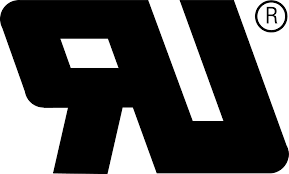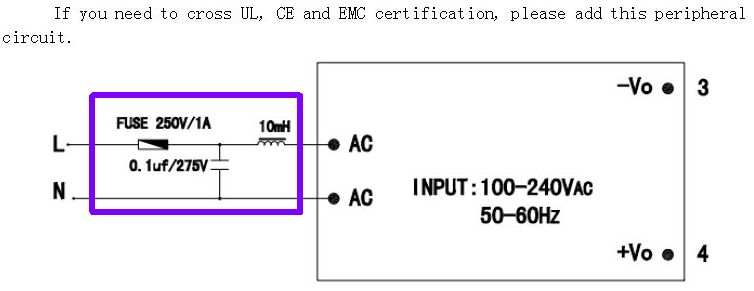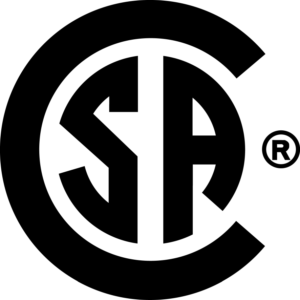Certificeringen – UL, CE, EMC, FCC, CSA
Hieronder staan diverse soorten certificeringen, wat ze zijn en waarom je ze nodig zou kunnen hebben.
Informatie: ENG/NL
The UL Listing Mark
This is one of the most common UL Marks. If a product carries this Mark, Underwriters Laboratories found that samples of this product met UL’s safety requirements. These requirements are primarily based on UL’s own published Standards for Safety. This type of Mark is seen commonly on appliances and computer equipment, furnaces and heaters, fuses, electrical panelboards, smoke and carbon monoxide detectors, fire extinguishers and sprinkler systems, personal flotation devices like life jackets and life preservers, bullet resistant glass, and thousands of other products.
Product testing can be verified through UL directories online at http://www.ul.com
UL catalogus: https://standardscatalog.ul.com/
The CE Mark
The European Commission describes the CE mark as a “passport” that allows manufacturers to circulate industrial products freely within the internal market of the EU. The CE mark certifies that the products have met EU health, safety and environmental requirements that ensure consumer and workplace safety. All manufacturers in the EU and abroad must affix the CE mark to those products covered by the “New Approach” directives in order to market their products in Europe. Once a product receives the CE mark, it can be marketed throughout the EU without undergoing further product modification.
Most products covered by New Approach Directives can be self-certified by the manufacturer and do not require the intervention of an EU-authorized independent testing/certifying company (notified body). To self-certify, the manufacturer must assess the conformity of the products to the applicable directives and standards. While the use of EU harmonized standards is voluntary in theory, in practice the use of European standards is the best way to meet the requirements of the CE mark directives. This is because the standards offer specific guidelines and tests to meet safety requirements, while the directives, general in nature, do not.
The manufacturer may affix the CE mark to their product following the preparation of a declaration of conformity, the certificate which shows the product conforms to the applicable requirements. They must maintain a technical file to prove conformity. The manufacturer or their authorized representative must be able to provide this certificate together with the technical file at any time, if requested by the appropriate member state authorities.
There is no specific form for the declaration of conformity, but specific information is required. The declaration must include the following:
(1) The manufacturer’s name and address.
(2) The product.
(3) The CE mark directives that apply to the product, e.g. the machine directive 93/37/EC or the low voltage directive 73/23/EEC.
(4) The European standards used, e.g. EN 50081-2:1993 for the EMC directive or EN 60950:1991 for the low voltage requirement for information technology.
(5) The declaration must show the signature of a company official for purposes of the company assuming liability for the safety of its product in the European market. This European standards organization has set up the Electromagnetic Compatibility Directive. According to CE, The Directive basically states that products must not emit unwanted electromagnetic pollution (interference). Because there is a certain amount of electromagnetic pollution in the environment, the Directive also states that products must be immune to a reasonable amount of interference. The Directive itself gives no guidelines on the required level of emissions or immunity that is left to the standards that are used to demonstrate compliance with the Directive.
Zelf een CE-Markering online aanmaken via ce-tool.com
The EMC-directive (89/336/EEC) Electromagnetic Compatibility
Like all other directives, this is a new-approach directive, which means that only the main requirements (essential requirements) are required. The EMC-directive mentions two ways of showing compliance to the main requirements:
- Manufacturers declaration (route acc. art. 10.1)
- Type testing using the TCF (route acc. to art. 10.2)
CE-markering elektromagnetische compatibiliteit (EMC) (2014/30/EU)
Inleiding EMC richtlijn
Richtlijn 2014/30/EU betreffende de harmonisatie van de wetgevingen van de lidstaten inzake het op de markt aanbieden van elektrisch materiaal bestemd voor gebruik binnen bepaalde spanningsgrenzen
De richtlijn beschrijft de vereisten aan elektromagnetische compabiliteit van elk apparaat of vaste installatie.
De uitzondering op de richtlijn zijn vaak al behandeld door andere richtlijnen, en daardoor niet van toepassing, zoals bijvoorbeeld radioapparatuur en telecommunicatie eindapparatuur.
Voor de EMC richtlijn zijn verschillende procedures voor conformiteit mogelijk, namelijk A, B en C. Deze zijn besproken in de bijlages (II-IV).
Toepassingsgebied en uitzonderingen van de richtlijn
Deze richtlijn reglementeert de elektromagnetische compatibiliteit van uitrusting. Zij strekt ertoe de interne markt naar behoren te doen functioneren door te eisen dat uitrusting voldoet aan een passend niveau van elektromagnetische compatibiliteit.
„uitrusting”: elk apparaat of vaste installatie;
Uitzondering (artikel 2)
uitrusting die onder Richtlijn 1999/5/EG (radioapparatuur en telecommunicatie-eindapparatuur) valt;
luchtvaartproducten, onderdelen en uitrustingsstukken als bedoeld in Verordening (EG) nr. 216/2008 van het Europees Parlement en de Raad van 20 februari 2008 tot vaststelling van gemeenschappelijke regels op het gebied van burgerluchtvaart en tot oprichting van een Europees Agentschap voor de veiligheid van de luchtvaart, houdende intrekking van Richtlijn 91/670/EEG, Verordening (EG) nr. 1592/2002 en Richtlijn 2004/36/EG;
radioapparatuur die wordt gebruikt door radioamateurs, zoals gedefinieerd in het radioreglement dat is goedgekeurd in het kader van het Statuut van de Internationale Telecommunicatie-unie en het Verdrag van de Internationale Telecommunicatie-unie, tenzij die apparatuur op de markt wordt aangeboden;
uitrusting die vanwege de inherente aard van haar fysische eigenschappen:
– geen elektromagnetische emissies kan produceren of niet kan bijdragen tot de productie van elektromagnetische emissies van een niveau dat hoger ligt dan het niveau waarop radio- en telecommunicatieapparatuur en andere uitrusting overeenkomstig hun bestemming kunnen functioneren, en
– zonder onaanvaardbare verslechtering functioneert in aanwezigheid van elektromagnetische storingen die normaal gesproken het gevolg zijn van het gebruik overeenkomstig haar bestemming.
op maat gemaakte evaluatiepakketten die bestemd zijn voor de beroepspraktijk en die uitsluitend worden gebruikt in inrichtingen voor onderzoek en ontwikkeling voor zulke doeleinden.
Voor de toepassing van de eerste alinea, onder c), worden bouwpakketten met onderdelen bedoeld om door radioamateurs te worden geassembleerd, alsmede op de markt aangeboden apparatuur die door en voor gebruik door radioamateurs is gewijzigd, niet beschouwd als op de markt aangeboden apparatuur.
Verplichtingen van fabrikanten
Wanneer zij hun apparaten in de handel brengen, waarborgen de fabrikanten dat deze werden ontworpen en vervaardigd overeenkomstig de essentiële eisen van bijlage I.
Fabrikanten stellen de in de bijlagen II of III bedoelde technische documentatie op en voeren de relevante in artikel 14 bedoelde conformiteitsbeoordelingsprocedure uit of laten deze uitvoeren.
Wanneer met die procedure is aangetoond dat het apparaat aan de toepasselijke eisen voldoet, stellen fabrikanten een EU-conformiteitsverklaring op en brengen zij de CE-markering aan.
Fabrikanten bewaren de technische documentatie en de EU-conformiteitsverklaring gedurende tien jaar nadat het apparaat in de handel is gebracht.
Bijlage I: Essentiële eisen
Algemene eisen
Uitrusting moet, rekening houdende met de stand van de techniek, zodanig zijn ontworpen en vervaardigd dat wordt gegarandeerd dat:
de opgewekte elektromagnetische verstoringen het niveau niet overschrijden waarboven radio- en telecommunicatieapparatuur en andere uitrusting niet meer overeenkomstig hun bestemming kunnen functioneren;
zij een zodanig niveau van ongevoeligheid voor de bij normaal gebruik te verwachten elektromagnetische verstoringen bezit dat zij zonder onaanvaardbare verslechtering van het beoogd gebruik kan functioneren.
Specifieke eisen voor vaste installaties
Installatie en beoogd gebruik van componenten:
– Een vaste installatie moet worden geïnstalleerd volgens goede technologische praktijken en overeenkomstig de informatie over het beoogde gebruik van de componenten, teneinde aan de essentiële eisen van punt 1 te voldoen.
Bijlage II en III
Bijlage II geeft de conformiteitsbeoordelingsprodecure via module A(interne productiecontrole). Met „interne productiecontrole” wordt de conformiteitsbeoordelingsprocedure bedoeld waarbij de fabrikant de verplichtingen in de punten 2, 3, 4 en 5 van deze bijlage nakomt en op eigen verantwoording garandeert en verklaart dat de betrokken producten aan de toepasselijke eisen van deze richtlijn voldoen.
Bijlage II geeft de conformiteitsbeoordelingsproceudure via module B en C.
Module B beschrijft het EU-typeonderzoek. Met „EU-typeonderzoek” wordt dat gedeelte van een conformiteitsbeoordelingsprocedure bedoeld waarin de aangemelde instantie het technisch ontwerp van een apparaat onderzoekt om te controleren of het aan de essentiële eisen in bijlage I, punt 1, voldoet, en een verklaring hierover verstrekt.
Module C beschrijft conformiteit met het type op basis van interne productiecontrole. Hiermee wordt dat gedeelte van een conformiteitsbeoordelingsprocedure bedoeld waarin de fabrikant de verplichtingen in de punten 2 en 3 nakomt en garandeert en verklaart dat de betrokken apparaten overeenstemmen met het type als beschreven in het certificaat van EU-typeonderzoek en voldoen aan de toepasselijke eisen van deze richtlijn.
dr. Rick Elbersen
Bron: euronorm.net
Voorbeeld met een (PCB) voeding met ontkoppel condensator en ontstoringsfilter:
The LVD-directive (73/26/EEC) Safety
Like all CE-related directives, this is a new-approach directive, which means that only the main requirements (essential requirements) are required. The LVD-directive describes how to show compliance to the main requirements.
The FCC Mark
The Federal Communications Commission (FCC) is an independent United States government agency that is directly responsible to Congress. The FCC was established by the Communications Act of 1934 and is charged with regulating interstate and international communications by radio, television, wire, satellite and cable. The FCC’s jurisdiction covers the 50 states, the District of Columbia, and U.S. possessions.
All devices that operate at a clock rate of 9 kHz are required to test their product to the appropriate FCC Code.
The CSA Mark
The Canadian Standards Association (CSA) is a nonprofit association serving business, industry, government and consumers in Canada and the global marketplace. Among many other activities, CSA develops standards that enhance public safety.
A Nationally Recognized Testing Laboratory, CSA is very familiar with U.S. requirements. According to OSHA regulations, the CSA-US Mark qualifies as an alternative to the UL Mark.
Here are some areas where CSA standards are applied:
- Canadian Electrical Code, Part III-Outside Wiring
- Electrical Engineering Standards
- Electromagnetic Compatibility
Bronnen:
batteryspace.com








